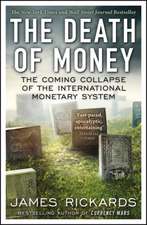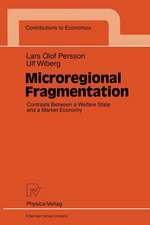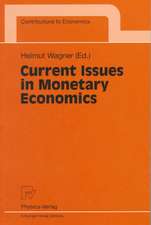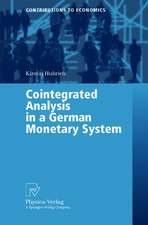Money Demand in Europe: An Empirical Approach: Contributions to Economics
Autor Christian Mülleren Limba Engleză Paperback – 23 iun 2003
Din seria Contributions to Economics
- 18%
 Preț: 1001.81 lei
Preț: 1001.81 lei -
 Preț: 90.83 lei
Preț: 90.83 lei - 15%
 Preț: 649.06 lei
Preț: 649.06 lei - 18%
 Preț: 1109.92 lei
Preț: 1109.92 lei - 24%
 Preț: 657.09 lei
Preț: 657.09 lei - 18%
 Preț: 976.54 lei
Preț: 976.54 lei - 17%
 Preț: 361.03 lei
Preț: 361.03 lei - 18%
 Preț: 1027.83 lei
Preț: 1027.83 lei -
 Preț: 283.93 lei
Preț: 283.93 lei - 15%
 Preț: 644.95 lei
Preț: 644.95 lei - 15%
 Preț: 638.24 lei
Preț: 638.24 lei -
 Preț: 394.29 lei
Preț: 394.29 lei - 15%
 Preț: 636.80 lei
Preț: 636.80 lei - 15%
 Preț: 637.78 lei
Preț: 637.78 lei - 18%
 Preț: 723.69 lei
Preț: 723.69 lei - 15%
 Preț: 635.47 lei
Preț: 635.47 lei - 15%
 Preț: 634.00 lei
Preț: 634.00 lei -
 Preț: 392.75 lei
Preț: 392.75 lei -
 Preț: 383.33 lei
Preț: 383.33 lei - 15%
 Preț: 637.28 lei
Preț: 637.28 lei - 15%
 Preț: 636.80 lei
Preț: 636.80 lei - 18%
 Preț: 950.96 lei
Preț: 950.96 lei - 15%
 Preț: 634.68 lei
Preț: 634.68 lei -
 Preț: 387.38 lei
Preț: 387.38 lei - 15%
 Preț: 647.27 lei
Preț: 647.27 lei - 15%
 Preț: 636.63 lei
Preț: 636.63 lei - 15%
 Preț: 639.73 lei
Preț: 639.73 lei -
 Preț: 385.62 lei
Preț: 385.62 lei - 15%
 Preț: 641.85 lei
Preț: 641.85 lei - 20%
 Preț: 649.60 lei
Preț: 649.60 lei - 15%
 Preț: 641.71 lei
Preț: 641.71 lei -
 Preț: 387.96 lei
Preț: 387.96 lei - 15%
 Preț: 645.47 lei
Preț: 645.47 lei -
 Preț: 385.08 lei
Preț: 385.08 lei - 15%
 Preț: 646.62 lei
Preț: 646.62 lei -
 Preț: 383.33 lei
Preț: 383.33 lei - 15%
 Preț: 638.43 lei
Preț: 638.43 lei -
 Preț: 381.21 lei
Preț: 381.21 lei - 15%
 Preț: 642.51 lei
Preț: 642.51 lei - 15%
 Preț: 637.78 lei
Preț: 637.78 lei - 15%
 Preț: 641.71 lei
Preț: 641.71 lei -
 Preț: 384.70 lei
Preț: 384.70 lei -
 Preț: 379.86 lei
Preț: 379.86 lei -
 Preț: 378.34 lei
Preț: 378.34 lei -
 Preț: 384.70 lei
Preț: 384.70 lei -
 Preț: 388.52 lei
Preț: 388.52 lei - 15%
 Preț: 641.71 lei
Preț: 641.71 lei -
 Preț: 381.00 lei
Preț: 381.00 lei - 15%
 Preț: 644.95 lei
Preț: 644.95 lei
Preț: 386.00 lei
Nou
Puncte Express: 579
Preț estimativ în valută:
73.88€ • 80.28$ • 62.10£
73.88€ • 80.28$ • 62.10£
Carte tipărită la comandă
Livrare economică 22 aprilie-06 mai
Preluare comenzi: 021 569.72.76
Specificații
ISBN-13: 9783790800647
ISBN-10: 3790800643
Pagini: 256
Ilustrații: XIV, 240 p.
Dimensiuni: 155 x 235 x 13 mm
Greutate: 0.37 kg
Ediția:Softcover reprint of the original 1st ed. 2003
Editura: Physica-Verlag HD
Colecția Physica
Seria Contributions to Economics
Locul publicării:Heidelberg, Germany
ISBN-10: 3790800643
Pagini: 256
Ilustrații: XIV, 240 p.
Dimensiuni: 155 x 235 x 13 mm
Greutate: 0.37 kg
Ediția:Softcover reprint of the original 1st ed. 2003
Editura: Physica-Verlag HD
Colecția Physica
Seria Contributions to Economics
Locul publicării:Heidelberg, Germany
Public țintă
ResearchCuprins
1 Introduction.- 2 Economic and Econometric Concepts.- 2.1 Introduction.- 2.2 Economics of the Demand for Money.- 2.3 System Analysis of Money Demand Functions.- 2.4 Summary. Econometric Analysis and Economic Interpretation.- 3 Unit Root Tests for Time Series with a Structural Break.- 3.1 Introduction.- 3.2 Models for Time Series with Level Shifts.- 3.3 The Test Statistics.- 3.5 Examples.- 3.6 Conclusions.- 3.A Figures.- 4 Monetary Policy in France Prior to European Monetary Union.- 4.1 Introduction.- 4.2 Preparing for the Euro: Implications for Money Demand Analysis.- 4.3 Money Supply in France Prior to EMU.- 4.4 Summary and Conclusion.- 4.A Data, Tables and Figures.- 5 Money Demand in Europe: Evidence from the Past.- 5.1 Introduction.- 5.2 Preliminary Considerations.- 5.3 Constructing European Data.- 5.4 Cointegration Analysis.- 5.5 Conclusions.- 5.A Appendix: Tables, Figures and the Data.- 6 Summary and Outlooks.- List of Tables.- List of Figures.- References.
Textul de pe ultima copertă
The EURO has now been in place for more than two years, but only the future will tell if the ECB policy proves successful in the long-term. Whether the monetary authorities have sufficient information, and more important, the right information to manage the EURO currency, has been an open question and will remain so for some time to come. This book discusses the economic principals underlying the demand for money as a potentially useful relationship for policy makers, and the possibilities to recover its properties by means of multivariate time series analysis. It applies the outcome of these considerations to the whole EURO area as well as to France. While for the aggregate, a money demand function can be specified and be shown to have good forecasting properties, this fails in the French case. This book puts forth economic arguments that attempt to explain this. At various steps of the analysis, special attention is given to breaks in time series data. The presentation carefully outlines all means that have been used to cope with shifts in coefficients of the cointegration relations. A separate chapter is dedicated to testing for unit roots in time series with level shifts. This includes detection of break points, provision of test statistics, graphical evaluation of the empirical models and illustration of the procedure with a large set of international macroeconomic data.
Caracteristici
Includes supplementary material: sn.pub/extras


















